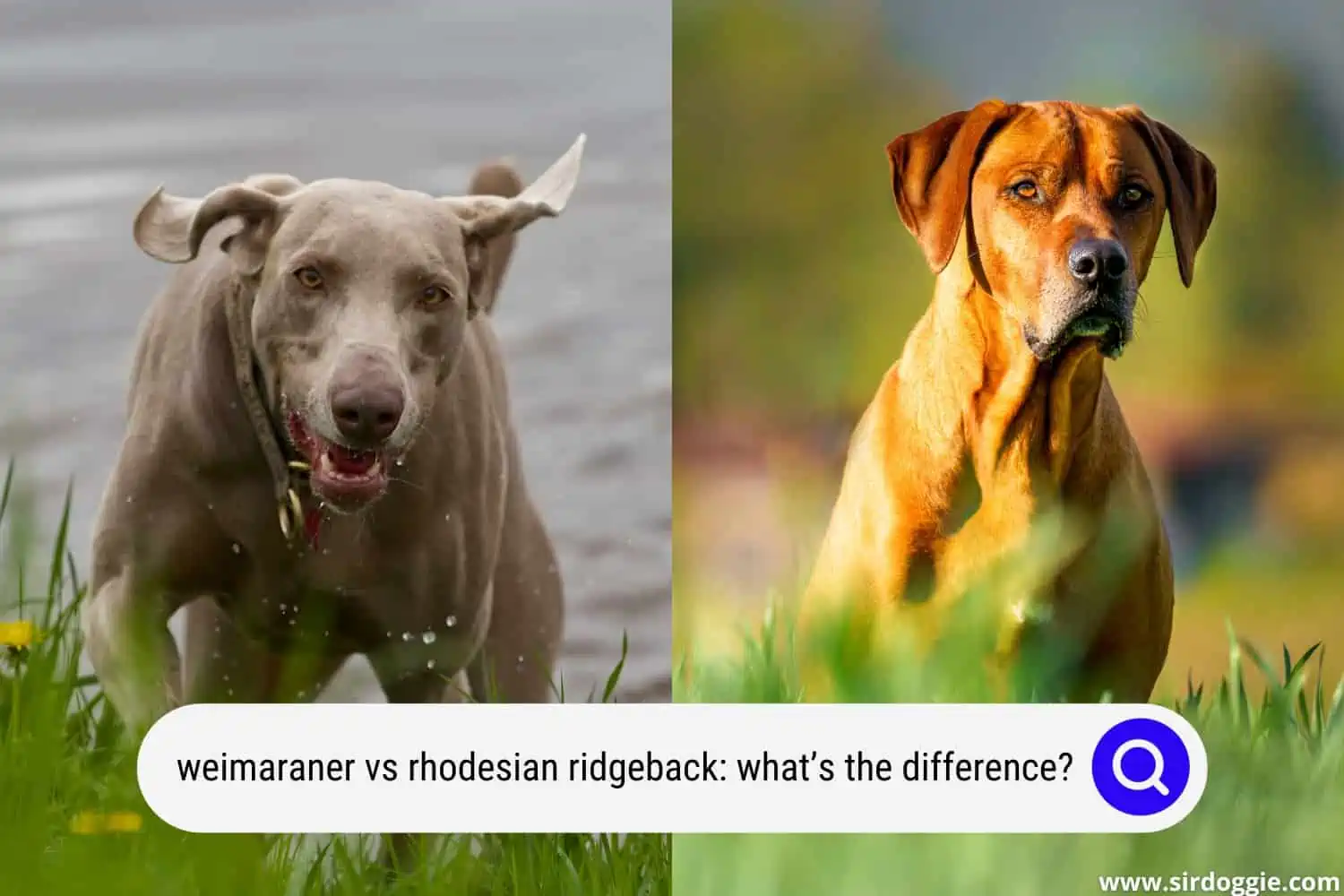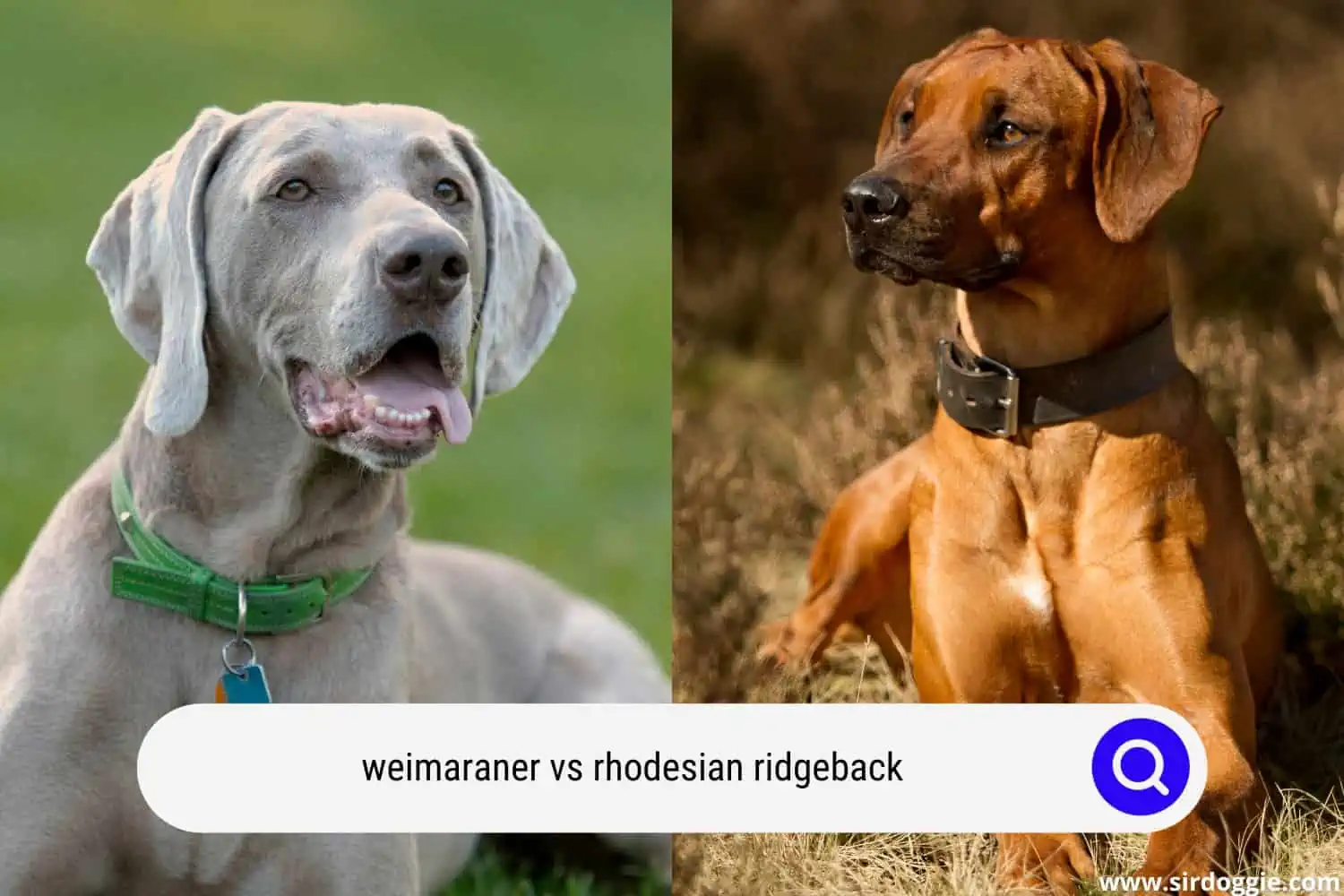Weimaraner vs Rhodesian Ridgeback: What’s the Difference?
The Weimaraner and the Rhodesian Ridgeback are two different dog species with distant origins. However, they are affectionate and relate well with children, other pets, and their owners.

One originates from Germany and the other from South Africa. In this article, we will help you choose the best between the two unique dog species.
About the Rhodesian Ridgeback
Also known as the African Lion Hound, the Rhodesian Ridgeback is a dog from southern Africa. The Rhodesian Ridgeback is a perfect life companion. It is endowed with a gentle, calm temperament.
The dog is affectionate and in constant need of affection although able to be alone. It is a very athletic dog with almost no need for maintenance. It is prone to some hereditary diseases that should be detected from an early age.
The Rhodesian Ridgeback is recognizable by the crest on its back. The gait of the Rhodesian Ridgeback is characterized by parallel, clear, and active movements.
Rhodesian Ridgeback: Physical features
Its coat is short, dense, smooth, and shiny. The dorsal ridge goes from behind the shoulders to the tip of the hip, tapering off. Its color ranges from light wheat to red tawny, with possibly a little white on the chest and fingers.
Its head is long, in harmony with the rest of the body. The skull is flat and wide between its ears. The stop is well-marked, but not excessively.
The nose is black or brown (going with the color of the eyes). The muzzle is long and powerful and the lips are clear. The jaws are strong, with the cheeks well chiseled.
Its ears are set high, of medium size, wide at their attachment, getting smaller and ending in a rounded point.
Their eyes are round in shape, moderately apart, and shiny, displaying a look full of liveliness and intelligence.
It is powerful and robust. The neck is quite long and strong, the back powerful, the chest well let down and ample, and the ribs well sprung.
Its tail is thick at its base, tapering towards its end, carried slightly curved upwards, but by no means curled.
Rhodesian Ridgeback: Behavior
Its intelligence is both its greatest quality and main flaw. If it’s not well-trained, it could be untenable. Fortunately, when taken early, it turns out to be fairly easy to train as long as you are firm, gentle, and fair.
You have to know how to reward the Rhodesian Ridgeback for every good deed, without overdoing it.
Never be aggressive when it does not execute an order well. It is preferable to have previous experience with a canine before taking care of this breed.
Do not hesitate to approach a professional trainer. It is recommended to bet on its intelligence and desire to please its master, by applying methods of positive reinforcement based on encouragement and rewards.
The Rhodesian Ridgeback is not picky compared to its surroundings. It adapts to all types of life, as long as it can go out for quite a long time daily.
It must be allowed to exercise itself every day to fully develop. The ideal living environment for this dog would be a house with a large fenced garden in which it could exercise and stand guard.
Rhodesian Ridgeback: Health
The Rhodesian Ridgeback has a robust nature and hardly suffers from any pathology. It is a purebred dog. However, it is prone to some hereditary diseases. These include coxofemoral dysplasia of the dermoid sinus which is a congenital effect of the skin.
An x-ray examination is essential to anticipate a possible disease. It also sometimes suffers from congenital myotonia, a defect that affects its muscles. It is however very resistant to cold and heat.
The life expectancy of a Rhodesian Ridgeback is, on average, between 10 years and 12 years.
Rhodesian Ridgeback: Maintenance and hygiene
The Rhodesian-Ridgeback is an easy to maintain dog. It is simply necessary to ensure that it receives its care regularly, without any negligence.
A single monthly or bi-monthly brushing is enough to allow it to maintain a beautiful coat.
It is advisable to brush the dog once a week to ensure the cleanliness of its coat and skin. Its eyes, the inside of the ears, the pads, and the interdigital spaces also need to be examined and cleaned regularly.
The annual maintenance cost of a Rhodesian Ridgeback is between $1,500 and $1,600.
The diet of the Rhodesian Ridgeback should be balanced and meet all of their needs. It is based on high-quality croquettes. For its ration, do not hesitate to contact a veterinarian.
The Rhodesian-Ridgeback needs one to two long walks a day to exercise and be stimulated. However, it is not recommended to subject it to exercises that are too intense so as not to strain its joints excessively. However, it is a physical activity seeker.
Rhodesian Ridgeback: Who is it suitable for?
The Rhodesian Ridgeback is a companion, hunting, and guard dog. Its many qualities make the Rhodesian Ridgeback an excellent dog for family life. It is very attached, faithful, and loyal to its master.
It is very caring for children. It is also kind to its adoptive family, not hesitating to protect and watch over them. The dog doesn’t show any aggression, especially with strangers but prefers to ignore them. It can be used in endless hunting parties.
About the Weimaraner
The Weimaraner is a smart breed of dog for its slenderness and beauty. It’s characterized by its grayish coat. Its skills have made it stand out as one of the most valued hunting dogs.
Nicknamed the “gray ghost”, this dog has a kind and patient character as well as enviable physical characteristics, perfect for active and dynamic families. There are short-haired and long-haired Weimaraner dogs. They originate from Germany.
Weimaraner: Physical features
The Weimaraner’s coat is short, coarse, and very thick most of the time, but some have a rather long coat. Regarding its color, it has shades of gray: mouse gray, silver-gray, or dark gray, resembling blue. Its head is proportional to the body and is narrower in females. The nose is large and long. Its ears are wide and long and reach the corners of the lips.
Its eyes are rounded and slightly oblique. They are blue from birth to 6 months, then take an amber color later on. Its body is long and firm. The tail is powerful and is carried quite low. It can be cut, however.
Weimaraner: Behavior and character
The Weimaraner is as good at hunting as it is at playing with children. Its inexhaustible dynamism makes it a real action dog. The dog adapts easily to any sporting activity even if its astonishing flair predisposes it to hunting. It can find games or even people without difficulty.
The Weimaraner needs firmness from an early age as it can be stubborn. The dog attaches very easily to his owners and feels a bit like a full member of the family. It is a dog that must therefore be accustomed to the lifestyle of the household as soon as possible so as not to feel abandoned or worse, to be bored. A bored Weimaraner can quickly become a bane to its owners.
Weimaraner: Health and hygiene
The Weimaraner is very hardy and does not encounter any major health problems. However, it is necessary to ensure that its vaccinations are up to date, especially if it participates in competitions and/or missions (research for the police or support of blind people for example). It is a breed predisposed to stomach upsets and certain dysplasias, but few individuals are affected by these diseases.
The life expectancy of a Weimaraner is, on average, between 10 years and 12 years.
The Weimaraner is a born athlete. It, therefore, needs to move all the time. Its coat does not need special maintenance. The Weimaraner only requires one brushing per week. You must clean its hair well during the molting period and carry out regular deworming.
Due to the risk of distortion of the stomach, the Weimaraner must eat 2 times a day at regular times. Its diet is based on high-quality croquettes.
The Weimaraner can not stand inactivity or be locked up all day. It takes more than 2 hours of walking per day to satisfy it.
Weimaraner: Who is it suitable for?
The Weimaraner can live in an apartment as long as it is outside several times a day and for a fairly long time. Walking in step doesn’t really interest the dog. It needs to run around to unleash its boundless energy. The ideal home for the Weimaraner is a residence with a courtyard and/or garden or a house in the country so that it does not get frustrated by staying locked up.
Related Reading: Weimaraner vs Doberman: What’s the Difference?
Comparison: Weimaraner vs Rhodesian Ridgeback
| Weimaraner | Rhodesian ridgeback | |
| Height at the withers | 59 to 67cm | between 63 and 69 cm |
| Weight | approximately 35 kg | between 30 and 40 kg |
| Color | Silver gray, deer gray, or mouse gray as well as transitions between these colors | from white wheat to reddish wheat. |
| Average life span | 12 years | between 12 and 15 years |
| Character | obedient, affectionate, and sweet | majestic, intelligent, and reserved with strangers. |
| Relationship with children | excellent | good |
| Relationship with other dogs | good | aggressive with other males. |
| Skills | pointer, retriever, search dog | companion dog, guardian, and, exceptionally, hunting dog. |
| Space needs | they need long daily walks | It fits perfectly in the home but needs daily exercise. |
| Food | approximately 500 g of dry food daily | about 500 grams of dry food daily. |
| Maintenance cost | high | moderate |

Conclusion
It’s hard to tell which is the better dog in this Weimaraner vs. Rhodesian Ridgeback comparison article. What you can consider the best for you depends on what you need a dog for.
If you need a versatile home companion dog that can also hunt and guard, and which has moderate maintenance needs and cost, with a longer lifespan, the Rhodesian Ridgeback is the best for you. However, if you need an athletic dog that can also be deployed for hunting or professional uses in the field, then the Weimaraner is for you.

Family Dog Expert Author
Hi there! I’m Stuart, a devoted dog lover and family dog expert with over a decade of experience working with our furry companions. My passion for dogs drives me to share my knowledge and expertise, helping families build strong, loving bonds with their four-legged friends. When I’m not writing for SirDoggie, you’ll find me hiking, playing with my beautiful dog, or studying music.